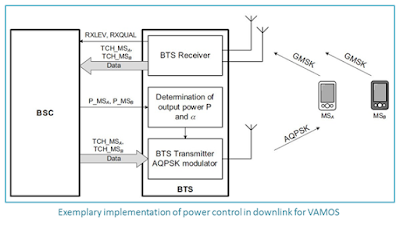BY engineer :abdallah Saleh
Adaptive QPSK (AQPSK) Modulation
In 1986 P. Laurent showed that
Gaussian Minimum Shift Keying (GMSK) phase modulation could be approximated by
Binary Phase Shift Keying amplitude modulated pulse.
VAMOS extends Laurent’s
approximation method to represent the superposition of two GMSK signals as a
single AQPSK modulated signal.
Symbol Rotation:
The modulating symbols are continuously rotated with 𝜑 radians per symbol to avoid transitions through the origin (ensure that the envelope of the signal does not go instantaneously close to zero). This minimizes the variations in the modulating signal which in turn minimizes the linearity requirements of the amplifier.
(i.e. each phase modulated symbol is additionally phase shifted by 𝜑 radians per symbol).
Symbol rotation φ depending on modulation:
AQPSK use π/2 symbol rotation to imitate GMSK, so legacy GMSK SAIC handsets can receive them separately.
Pulse Shaping:
The process of changing the waveform of transmitted pulses; its purpose is to make the transmitted signal better suited to its purpose or the communication channel, typically by limiting the effective bandwidth of the transmission.
By filtering the transmitted pulses this way, the inter-symbol interference caused by the channel can be kept in control. In RF communication, pulse shaping is essential for making the signal fit in its frequency band.
facebook page
VAMOS DL Power Control
VAMOS Sub-channel Power Control feature adapts the AQPSK modulation constellation to distribute the downlink transmit power between the two sub-channels of the AQPSK modulated carrier. Extra power can be distributed to one of the sub-channels, at the expense of the paired sub-channel. This mechanism is important since it allows legacy mobiles to operate in VAMOS mode.
The position of the AQPSK symbols, and thus the power distribution between the sub-channels, defined by the Sub-channel Power Imbalance Ratio (SCPIR), are controlled by the VAMOS Sub-channel Power Control.
Power Control in downlink for VAMOS is done in two successive stages:
-Determination of the required transmit power levels for both mobile stations MS-A and MS-B according to the radio link measurement reports (RXLEV and RXQUAL) received from these mobiles. The BSS determines the power level P MSA required for MS-A in the first sub-channel and P MSB for MS-B in the second sub-channel.
-Determination of the corresponding AQPSK signal constellation and output power for the AQPSK signal. A control unit in the BTS computes a combination of output power P and α that gives the required combination of P MSA and P MSB in downlink based on the following relationship: P = P MSA + P MSB = P × cos2 α + P × sin2 α
facebook page
VAMOS MS Categories:
For several years now, many mobiles have been equipped with SAIC receivers to improve their resistance against inter-cell interference, i.e. not even with VAMOS in mind.
In other words, when VAMOS gets deployed one does not have to wait for special VAMOS capable devices to reach a critical mass before the benefits can be seen. However terminals that support VAMOS feature increase performance of the BSS VAMOS feature.
Legacy Non-SAIC:
-Don’t support SAIC algorithm or TSC Set 2
-Can’t be paired with a legacy non-SAIC MS or legacy SAIC MS.
-May be multiplexed on the VAMOS sub-channel in the case of much power offset.
Legacy SAIC:
-Support SAIC algorithm but not support TSC Set 2
-Does not require much power offset.
VAMOS level I:
-Support SAIC algorithm and TSC Set 2
VAMOS level II:
-VAMOS II user devices must cope with strong negative SCIPR values, which will likely require implementation of joint detection techniques in the receiver. Therefore VAMOS I and II requirements will differ by verifying voice performance at different SCPIR proof points. VAMOS I user devices will be tested at SCPIR = -4dB, 0dB and 4dB, whereas VAMOS II user devices will need to fulfill reference performance additionally at SCPIR = -8dB and SCPIR = -10dB.
The VAMOS-aware mobiles are expected to be served on the weaker sub-channels when being multiplexed with legacy mobiles.
Sub-channel Power
Imbalance Ratio (SCPIR) is defined by;
Assuming
that MS-B receives the quadrature component and MS-A the in-phase component of
the AQPSK signal.




